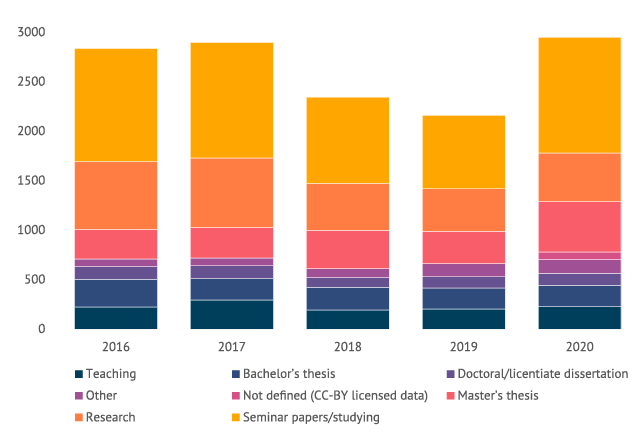Looking at the bright side of 2020: data use skyrocketed in the year of COVID-19
In 2020, users downloaded datasets from Aila Data Service more than ever before. FSD archived and processed more datasets in 2020 than in 2019, and the number of registered users grew. The exceptional year of the coronavirus pandemic showed that the services provided by FSD are well suited for remote work and studying.
Datasets were widely used in Finnish higher education institutions. The most data were downloaded at Tampere University (19%) and the Universities of Helsinki (11%), Jyväskylä (9%) and Turku (9%). 7 percent of the dataset downloads came from registered users abroad (2019: 7%), and one in six datasets were downloaded from the English data catalogue of Aila.
Last year, data downloads saw a remarkable increase of 36 percent from 2019. In total, FSD processed 2,598 access applications in 2020 (2019: 1 882). 2,947 datasets were delivered for reuse (2019: 2 159), of which 78% were quantitative (2019: 80%) and 22% qualitative (2019: 20%). A single user can download the same dataset multiple times while the access application is in effect, which is why the number of datasets distributed for reuse is higher than the number of processed access applications. All in all, between 2014 and 2020, approximately 16,600 datasets have been downloaded from Aila.
Users downloaded datasets most actively in February, October and November. Between April and June, the first months of the COVID-19 crisis, data downloads also saw an increase when compared to past springs.
Archived research data widely used for study purposes
Most of the datasets were used for seminar papers and other study purposes (40%). Additionally, datasets were distributed for theses, such as Bachelor’s, Master’s and Doctoral theses (in total 29%), other research (17%), and teaching (8%). Utilising an existing dataset appeals to both registered users and the users of openly accessible data. The figure below illustrates dataset downloads according to purpose of use between 2016 and 2020.

The most popular dataset in 2020 was (Opens in a new tab), which studied views on climate change, energy security and well-being. Of the datasets published in 2020, the most downloaded datasets were (Opens in a new tab), (Opens in a new tab) and (Opens in a new tab).
Increase in the number of archived datasets and registered users
FSD’s data repository gained 98 new datasets in 2020 (2019: 84). 91 new datasets were published on Aila (2019: 77): 65 quantitative datasets (2019: 52) and 26 qualitative datasets (2019: 25). At the end of 2020, Aila contained a total of 1,581 datasets, of which 1,327 were quantitative and 254 qualitative. Eight openly accessible datasets were published on Aila Data Service in 2020. By the end of the year, a total of 93 openly accessible datasets were available for download.
Datasets available for (B) research, teaching and study were the most popular last year (65% of downloads), followed by datasets that are (A) freely available without registration (28%). Of all datasets on Aila, datasets with access condition (B) account for 75 percent, whereas datasets with access condition (A) account for 6 percent.
In 2020, 1,076 unique registered users downloaded data from Aila (2019: 768). Overall, there were 2,824 registered Aila users at the end of 2020 (2019: 2 623).
The overall use of the FSD website also grew notably in 2020; the number of site requests increased by 7 percent compared to 2019. The Data Management Guidelines and the Research Methods Web Resource (MOTV) grew the most in popularity. You can learn more about data use rates and other FSD operations in the annual report published online later this spring (in Finnish).